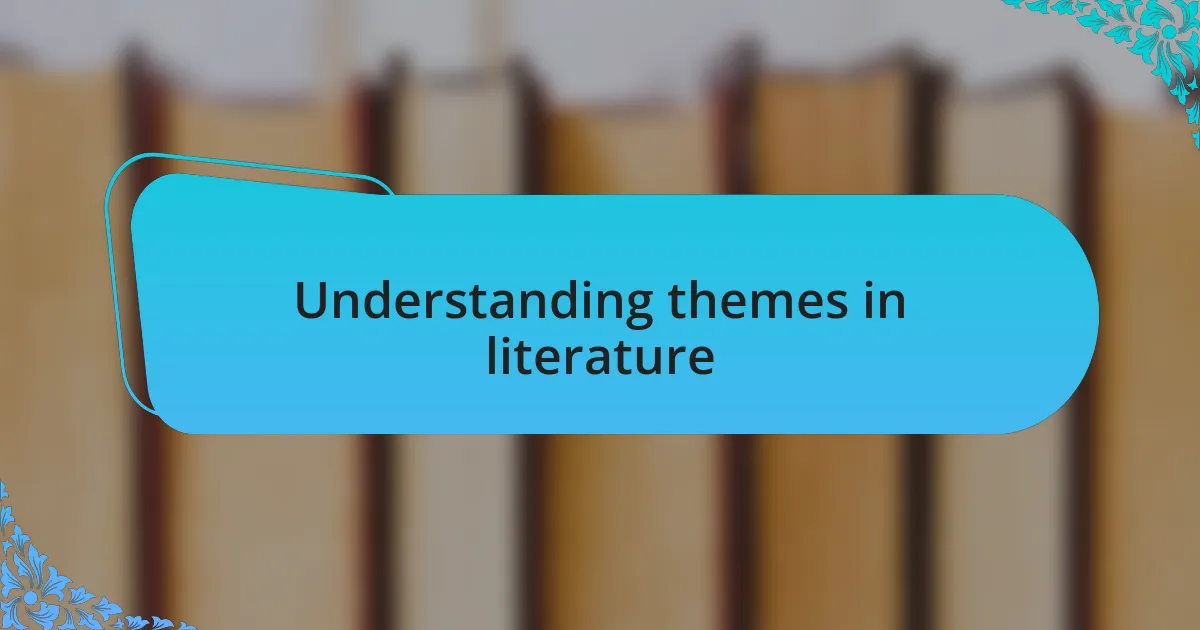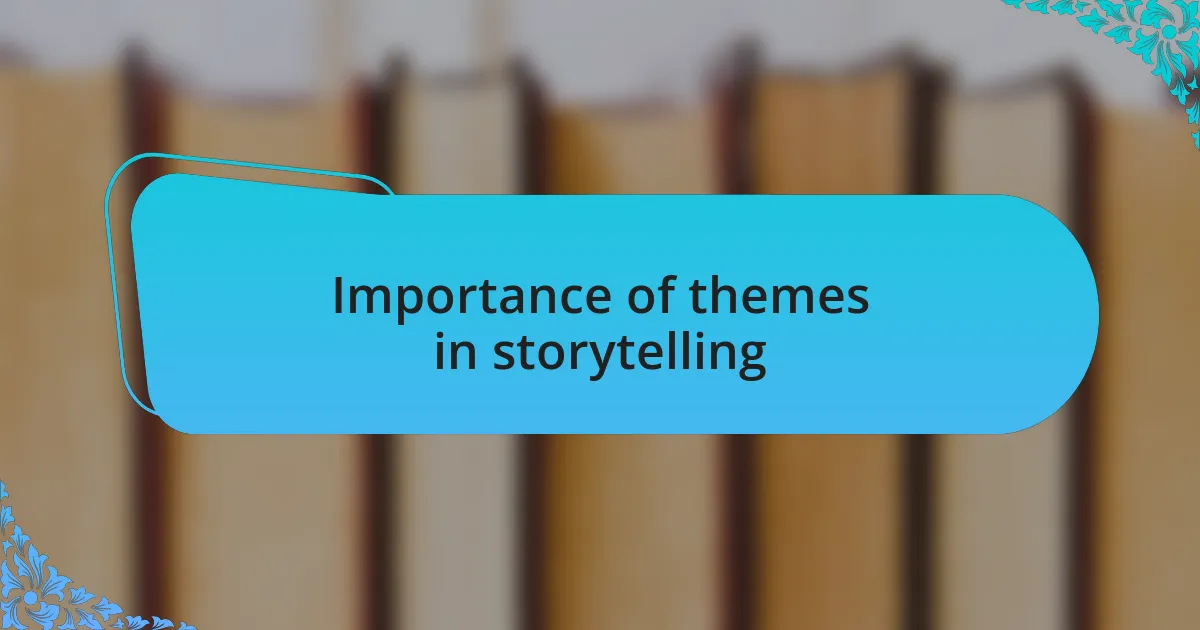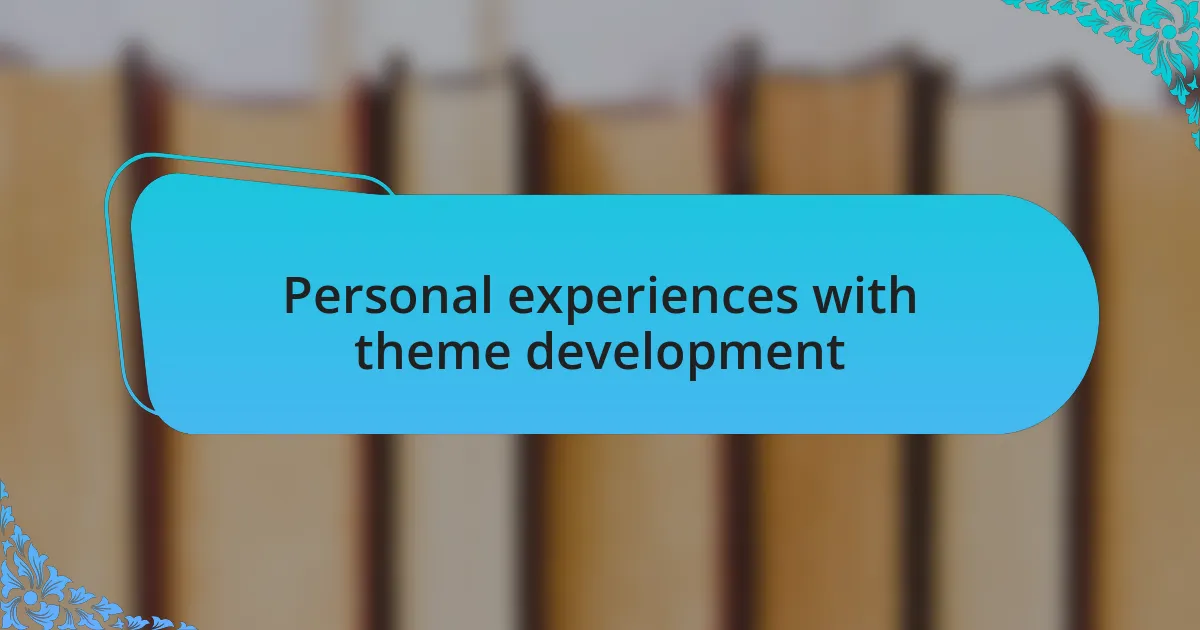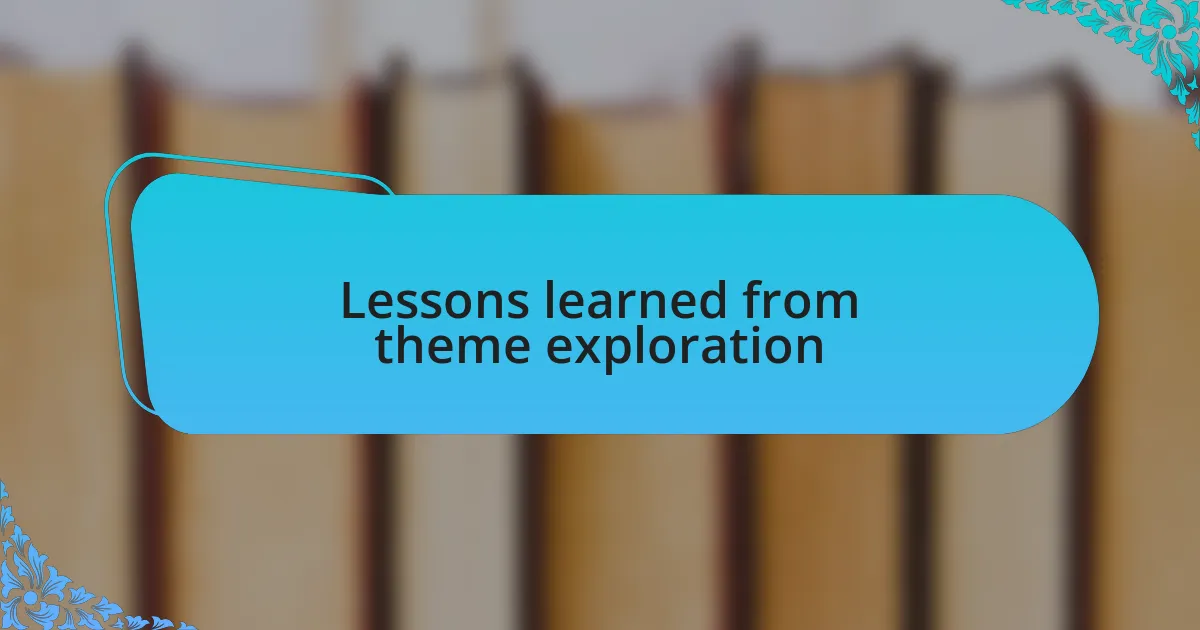Key takeaways:
- Themes in literature provide emotional depth and connect readers to the story, often reflecting personal experiences and societal values.
- Identifying themes involves exploring core emotions, symbols, and reader feedback, which enriches the narrative and reveals deeper layers.
- Developing themes through personal experiences and contrasting characters enhances authenticity and invites reader introspection.
- Exploring themes fosters vulnerability and personal growth, allowing writers to connect with their audience and reflect on their own journeys.

Understanding themes in literature
Themes in literature are like the underlying currents that shape a story’s meaning. For me, discovering these themes often feels like peeling an onion; each layer reveals deeper layers of understanding. I remember reading a novel where the theme of isolation resonated with my own experiences during a particularly lonely time in my life. It made me wonder: how often do we overlook the emotional depth behind a character’s journey?
The beauty of literature is that themes can evoke powerful emotions and provoke thought. When I write, I often ask myself what message I want to convey and how it resonates with my own experiences. I once crafted a story centered around the theme of friendship during challenging times, drawing from my own circle of friends who supported me through thick and thin. Those nuanced relationships added authenticity and an emotional layer that I hope readers can connect with.
Understanding themes also involves interpreting how they reflect societal values and personal truths. Think about the themes in your favorite stories: what messages do they convey about humanity? In my own work, I explore themes like resilience in the face of adversity, drawing inspiration from real-life stories that uplift and motivate me. This blend of personal experience and broader societal reflection enriches the narrative and invites readers to find their own meanings.

Importance of themes in storytelling
Themes are essential in storytelling because they connect readers to the story on a deeper level. I remember crafting a short story that explored the theme of forgiveness. It was a cathartic experience for me—revisiting my past grudges and the weight they carried. Have you ever thought about how much lighter you feel when you let go of resentment? That realization made its way into my narrative, making it resonate with readers in unexpected ways.
When I consider the importance of themes, I often think about how they serve as the backbone of a narrative, giving direction and purpose. For instance, while writing a piece about the theme of identity, I used my own journey of self-discovery to infuse authenticity into the characters. As I reflected on my experiences, I asked myself: What does identity really mean in today’s world? By addressing this question, I encouraged readers to explore their own identities alongside the characters, fostering a shared sense of introspection.
Themes not only shape individual stories, but they also create a landscape for broader conversations about life. In my poetry, I often tackle the theme of love lost, drawing from the bittersweet memories of past relationships. This theme resonates with so many because love is a universal experience that connects us. Have you ever read a poem or a story that made you reflect on your own love life? It’s moments like these that give stories their enduring impact, inviting readers to reflect on their feelings and experiences.

Ways to identify themes
To identify themes in my work, I often start by reflecting on the core emotions I want to convey. For instance, during a recent writing project, I delved into the theme of resilience. After pondering moments in my life when I faced challenges, I connected those feelings with my characters’ struggles. Have you ever noticed how powerful a character’s journey can be when it mirrors the resilience we experience in our own lives? This alignment creates a deeper resonance for both the writer and the reader.
Another effective method I use is examining recurring symbols or motifs within my narratives. While working on a story that featured a decaying house, I realized it represented lost dreams and nostalgia. It struck me how certain elements, like this house, can embody larger themes. When I saw the house through the lens of my characters’ emotions, it sparked questions: What memories linger in our own lives? How do they shape our present? This exploration often reveals rich thematic layers to my work.
Lastly, engaging with beta readers can shed light on themes I might overlook. Their feedback often highlights elements they resonated with, leading me to recognize connections I hadn’t consciously intended. I vividly recall sharing a draft about friendship, and one reader mentioned how it reminded them of a pivotal moment in their life. That insight made me rethink the angles of my story, transforming it into a richer exploration of friendship’s complexities. Have you ever missed a theme that someone else immediately recognized? These interactions not only enrich my writing but also forge a collective understanding that deepens the thematic experience.

Methods for developing themes
When developing themes, I often turn to personal experiences to bring authenticity to my work. For example, while exploring the concept of grief in one of my stories, I drew from a transformative moment after losing a close friend. I found that writing about the raw emotions I felt allowed me to craft a narrative that resonated deeply with others. Can you think of a time when your own experience enriched your storytelling?
Another method I employ is the use of contrasting characters to highlight thematic conflicts. While writing a story centered on ambition versus contentment, I created two protagonists whose paths were diametrically opposed. This tension not only showcased their struggles but also invited readers to reflect on their own values. Have you ever noticed how the clash of opposing ideas can illuminate a theme in unexpected ways?
I also enjoy experimenting with different narrative styles to deepen thematic exploration. When I wrote a piece through alternating perspectives, I discovered how each character’s viewpoint added a unique layer to the overall message. This technique opened up dialogues about empathy and understanding, bringing readers closer to the characters’ emotional worlds. Isn’t it fascinating how shifting perspectives can enrich our understanding of a theme?

Personal experiences with theme development
When I reflect on my journey with theme development, one experience stands out vividly. I wrote a story about the struggle for identity, inspired by my own feelings of displacement during a move to a new city. The loneliness and excitement I felt became a canvas for me to explore how our environments shape who we are. Have you ever found that your sense of belonging can shift dramatically based on where you are?
Another powerful moment came when I tackled the theme of resilience after a personal setback. After a failed project that left me questioning my abilities, I penned a narrative about characters who faced crushing defeats but rose again stronger. This exploration helped me to not only process my own struggles but also inspire others who might find themselves in similar situations. Isn’t it incredible how vulnerability can create powerful connections through storytelling?
I’ve also found that intertwining themes can create a richer narrative. For instance, while writing about love and sacrifice, I reflected on my relationship with my family. Their unconditional support often came at a cost, and portraying that dynamic added depth to my characters. Have you ever considered how the intersection of different themes can reveal deeper truths in your own writing journey?

Examples from my work
One of my favorite examples of theme development arose from a seemingly ordinary moment: a Sunday afternoon walk in the park. Observing the interactions between families, friends, and strangers sparked an exploration of the theme of connection. I wrote a piece that delved into fleeting encounters, highlighting how a simple smile or shared laughter could momentarily bridge the gaps between our individual lives. Have you ever noticed how some brief interactions can linger in your memory long after they’ve passed?
Another noteworthy instance was when I reflected on the theme of memory and loss through a character who suffered amnesia. This character’s struggle to reclaim her past mirrored my own experiences of grappling with memories that often felt just out of reach. Writing about her journey of rediscovery allowed me to process my own feelings about the importance of memories, both sweet and painful. Isn’t it fascinating how the act of writing can serve as a form of catharsis, guiding us through our emotional landscapes?
In a recent project, I tackled the theme of societal expectations by drawing parallels between my past aspirations and the pressures I faced from those around me. I developed a character who rebelled against the traditional path laid out for her, inspired by my own decisions that sometimes diverged from expectations. As I wrote, I couldn’t help but reflect: how liberating is it when we embrace our true selves, rather than conforming to others’ visions for us? This exploration not only showcased her journey but also challenged me to interrogate my own choices.

Lessons learned from theme exploration
It’s fascinating how exploring themes can reveal unexpected lessons about myself and the world around me. For instance, while exploring the theme of resilience, I drew inspiration from a time I faced a personal setback. Writing about my character’s determination to overcome obstacles reminded me of the strength we often don’t realize we possess until we confront challenges head-on. Have you ever found that the act of putting your struggles into words can bring clarity and understanding?
Another key lesson I’ve learned is the importance of vulnerability in theme exploration. When I wrote about the theme of love, I dug deep into my own experiences, exposing my fears and joys associated with relationships. This openness not only deepened the emotional resonance of my work but also encouraged my readers to reflect on their own relationships. How often do we shy away from expressing our true emotions, fearing judgment? Embracing vulnerability in my writing has created a powerful connection with my audience.
Additionally, I’ve come to realize that themes can be fluid and evolve over time. When I initially tackled themes of identity, I thought I had a clear direction. However, as I revisited my drafts, I noticed new layers of complexity emerging. Each revision revealed different aspects of my own identity that I hadn’t considered before. How enriching it is when we allow our themes to mature alongside our personal growth? This ongoing exploration has taught me that the journey of developing themes is as important as the final product.